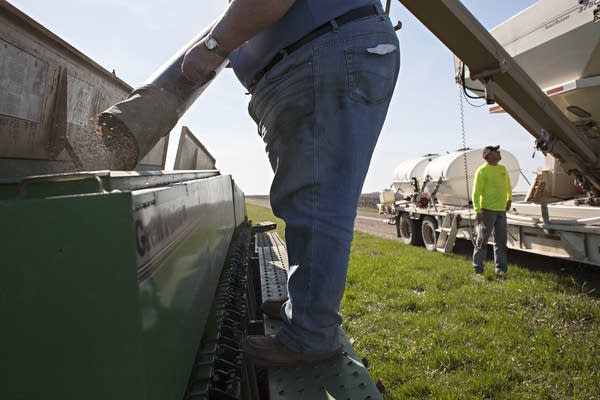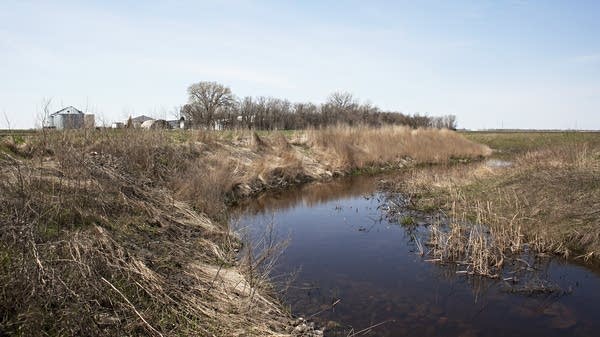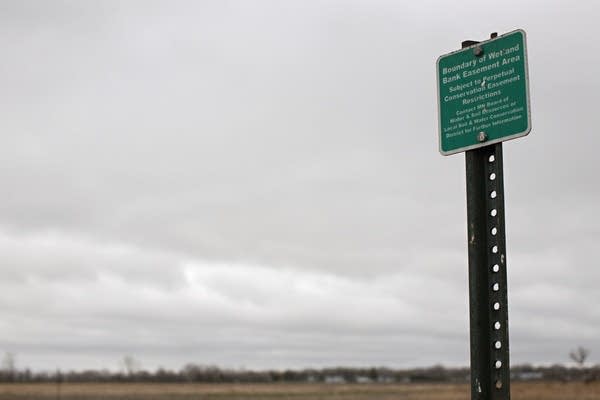Random acts of conservation: Water quality depends on farmers' willingness, not regulation

Go Deeper.
Create an account or log in to save stories.
Like this?
Thanks for liking this story! We have added it to a list of your favorite stories.
Farming is a big part of Minnesota's clean water problem.
The Minnesota Pollution Control Agency estimates that 40 percent of the state's lakes and streams are polluted. Much of that pollution is from soil, fertilizer and other contaminants flowing off farm fields — and cleaning it up is almost solely reliant on the goodwill of farmers. Cropland isn't regulated as a pollution source.
On the national level, the Federal Clean Water Act regulates pollution flowing out of pipes, known as point source pollution. But contaminants flowing off of farm fields — non-point source pollution — are exempt from regulations.

With little authority to compel farmers to adopt clean water practices, state and federal agencies rely on a voluntary approach. As a result, farming practices can be dramatically different from one field to the next.
Turn Up Your Support
MPR News helps you turn down the noise and build shared understanding. Turn up your support for this public resource and keep trusted journalism accessible to all.
On the western edge of the state, a weblike network of streams and rivers flow from Minnesota lake country, across miles of rich farmland and on to the Red River. Many of the streams are in poor condition, loaded with soil and fertilizer from farm fields.
A few hundred miles north, the pollution contributes to a growing dead zone in Lake Winnipeg, the 10th largest freshwater lake in the world.

The Buffalo-Red River watershed district covers about 1,800 square miles, really just a dot on the map of Minnesota.
But it's a prime spot where agriculture and water meet.
The Nordick Farm: A conservation all-star

About 45 minutes south of Moorhead, Minn., Jared Nordick's farm is considered a model for improving water quality. He raises corn, soybeans and wheat with his dad, Jerry.
A couple years ago, the younger Nordick jumped at the chance to become the first Minnesota farm certified under the state ag department's new agricultural water quality certification program.
"I said, Yes, I'm proactive. I want to do it,'" Jared Nordick said. His father wasn't so sure.
"My dad said, 'Whoa boy! Don't get involved with that! You never know what bureaucrat agency is going to get involved. Holy moly, they're gonna clean you out.' Well, you know what? Sometimes you have to open things up and learn from our mistakes."

It turns out that Nordick wasn't making many mistakes. He had grass buffers along a small stream that runs across the farm; he had a plan to manage nitrogen and phosphorus fertilizer; and he follows all the recommended farming practices.
And because he's joined the program voluntarily, he will be exempt from new environmental regulations for the next 10 years.
And Nordick, 38, continues to experiment: He's using less nitrogen fertilizer on his corn than is recommended by the University of Minnesota.

"I talk to my neighbors, and we're still seeing the same kind of yields they are, so I think we need to start seeing a movement by other farmers to start saying, 'Hey, you know, let's pull it back 20 units this year on a small strip and then do another 20 the next year,'" he said. "And until you start to see a deficit, why over-apply?"
That's a decision based on economics, not environmentalism.
But Nordick considers himself a conservationist, and is eager to show off some projects that don't help his bottom line. He's been farming this land since he was 15, he said, and taking care of it is a matter of pride.
Like thousands of Minnesota farmers Nordick uses drainage systems buried in the soil: Perforated pipes, known as drain tiles, carry excess water to a ditch or stream. But water from these tile drainage systems often carries a lot of potentially toxic nitrate from fertilizers, a major source of water pollution across the state.
So, instead of dumping that water directly into a stream, Nordick decided to use a saturated buffer. The idea is to use plants and soil to filter nitrate from the tile water before it flows into the stream. The state agriculture department will monitor the site to see how well it works.
He pays 25 percent of the project cost; government programs pay the rest. Nordick says that's typical for many conservation programs.

The buffer uses one acre in the corner of this field. Instead of corn, the land will grow wildflowers for bees and butterflies.
"You know, we're not financially going to gain anything from that," he said, "but in the big picture, somebody else is. So sometimes you've just gotta do it because it's in your heart as a conservationist."
Nordick is a star in the Minnesota Agricultural Water Quality Certification Program, a cornerstone of the Minnesota ag department's efforts to clean up dirty water.

But here's the catch: Jared Nordick is reducing fertilizer use and putting in buffers because he wants to. It's all voluntary.
"The problem is if every farmer in a watershed were certified and followed the certification practice, we still would have heavily polluted water," said Steve Morse, executive director of the Minnesota Environmental Partnership.
A variety of experts agree that even if all Minnesota farmers followed these best practices in water management, the results would only get the state about halfway to its water quality goals.
So far, 124 Minnesota farms are signed up for the ag water quality program. There are about 74,000 farms across the state.
The Zimmerman Farm: Water as a business decision

An hour north of the Nordick farm, Gerry Zimmerman bristles at some of the policies Jared and his father have embraced on their farm.
"The government seems to be entirely against what farmers are trying to do, as far as producing crops," Zimmerman, 68, said. He farms about 2,000 acres with his son a few miles north of Moorhead, growing corn, beans and sugarbeets.
The government, he said, keeps changing the rules. It once paid him to ditch and drain every acre of land.
"Now that picture has changed entirely, where it's more about preserving the potholes in the fields and stuff like that," he said. "You know: This should all be potholes out here and swamps so the ducks can go through. It's a crazy world."
Zimmerman said clean water is important, but he's not convinced that requirements like stream and ditch buffers are the answer. He sees a new state law requiring grass buffers along streams and ditches as government overreach.

"If they can prove to me that it's actually polluting the water down in the ditch, I guess then, okay, put the damn thing in," he said. "But don't just come and say, 'We're going to take your land — and, tough — because it's the law.'"
For Zimmerman, every decision comes back to the bottom line. He finds himself fighting the endless battle against too much water on his cropland — water that can delay planting, reduce his harvests and cost him money.

"I wouldn't say I'm a conservationist, I'm a farmer," he said. "I'm probably a realist more than a conservationist. We don't over-fertilize because it costs too much money to do that. It's a business. If I can do that and save a lot of money, great."
But decisions on individual farms impose financial and environmental costs far beyond their reaches.
The crumbling field: Toothless policies in action
It's Bruce Albright's job to cajole and convince landowners to support conservation projects. In his role as head of the Buffalo-Red River Watershed District, he sees daily how the toothless nature of U.S. policy has hurt water quality.
Down a gravel road a few miles from the Nordick farm, is a field that's frustrated Albright for years.

In the summer of 2011, floodwaters washed away so much soil from the field, there was a twisting gash in the earth nearly a mile long and several feet deep, all the way down to the rock in some places.
Since then, the farmer who owns the field has refilled that big washout with more dirt, but Albright says there's nothing there to stop erosion. The farmer refuses to plant grass or put in buffers. And there's nothing Albright can do about it.
"When we have the next major flood, it will look like it did after the last flood," he said.
Ironically, this erosion is partially the result of past government programs. In the early 1900s the government paid to turn the Buffalo River into a straight ditch here. The idea was to get water off of farm fields more quickly. But when there's a big spring snowmelt or heavy rain, the water returns to its original channel through this field.
The farmer who owns the field didn't answer calls seeking an explanation. But soil loss is a massive problem. U.S. Department of Agriculture data shows that, on average, every square mile of cropland in Minnesota loses 6 tons of dirt a year. That's about 300 dump truck loads off every square mile of cropland.
That lost soil carries nutrients into streams, rivers — and, eventually, places like the Gulf of Mexico and Lake Winnipeg where excess nutrients are causing dead zones — oxygen-starved areas where aquatic life can't survive.

All the soil from this particular field has moved downstream into the Buffalo River. In some places, sediment five feet deep clogs the stream. The watershed district's property taxpayers — not the farmer — are shouldering the cost to remove the sediment as part of a restoration project. And that riles Bruce Albright.
"There's a reason why we're taking out five foot of sediment downstream of this," he said. "That's your soil that's in there, you pay to take it out."
As it stands, no one can force the farmer to cover the costs of his erosion. But Albright will soon have a new option to force action. An expanded state soil erosion law could force the farmer to take action to stop future erosion.
"I always kinda like to operate under the theory [that] right is right and wrong is wrong," Albright said.
The soil erosion rule is still being developed by the Minnesota Board of Water and Soil Resources. Assistant director Doug Thomas said the law has actually been on the books since 1984. It gave counties authority to adopt an ordinance covering erosion, but Thomas said only five counties in southeastern Minnesota passed one.
Now, Thomas said, it will become a statewide process in which anyone can file a complaint about excessive soil erosion.

"And then it kind of almost becomes a neighborhood thing, where somebody says, 'Well geez, what about so-and-so over there?'" he said. "Time will tell about people's willingness to initiate or file a complaint."
Targeting conservation, he added, is critical to improving water quality. Bad farming practices can undo the work of those trying to reduce erosion. And he said landowners need targets, so they can understand the scope of the problem.
The state is moving towards a watershed approach that will eventually lead to setting those goals. The Buffalo-Red River Watershed District, Thomas said, is a good example of where targeted conservation is happening.
The Anderson farm: Restoring Stony Creek
Stony Creek flows directly into the Buffalo River.
It's another of the many streams the government paid to straighten a century ago, an effort that left a legacy of problems in this area. Old records show the budget for digging this ditch was about $4,000. It was completed in 1916.
Bruce Albright, the watershed manager, is working on a plan to return the stream to its original meandering channel — at a cost of about $12 million.
"Maybe in a couple of years we can watch construction start," he said.
The project will also include a deal to pay local landowners to allow farm fields here to flood whenever the water is high. That will filter sediment and fertilizer from the water before it flows downstream.

Farmer Chuck Anderson supports the effort. His land will likely be flooded in the spring, after the project is built, which means he might plant grasses to harvest for seed instead of his usual corn and soybeans.
"I think we're just mining the soil too much," he said. "We're just not giving it a break. And, to a point, as a farmer if you're a true conservationist or whatever, you want this around for the next generation, too. I guess that's how I look at it."
Minnesota's nutrient reduction strategy calls for more "living cover" on the landscape. Living cover might be permanent grassland, or it might be crops other than corn and soybeans; crops that better protect soil from erosion.
Minnesota's short growing season makes cover crops a challenge in many parts of the state — they're typically planted after the fall harvest to keep the soil covered and reduce erosion.
And projects like the one near Anderson's farm often take years. First, landowners need to be convinced it's a good idea. Then funding needs to be cobbled together from a variety of federal, state and local sources.
The Stony Creek project might only make a small difference in the Buffalo River's water quality, but Bruce Albright calls it a step in the right direction. He has another 10 projects on his to-do list.
Multiple agencies, significant spending, unclear results
Not only is there a lack of jurisdiction over damaging farm practices, authority over water quality in Minnesota is splintered across at least six different state agencies. And enforcement at the county level varies widely.
Conservation efforts are fractured and spread across an alphabet soup of federal and state programs: ACEP ... EQIP ... AWEP ... WRP ... CRP ... GRP ... CSP... There are more than 17 different federal programs focused on conservation efforts.
And a lot of money — on the federal, state and local levels — goes toward conservation efforts.
The Environmental Working Group counted more than a billion federal dollars spent on conservation programs in Minnesota over from 2005 to 2014.

And the Minnesota Clean Water Fund has spent about $500 million in the state since 2010.
But it's not enough to simply ask farmers to do the right thing, said Steve Morse, the Minnesota Environmental Partnership director.
"We've spent many millions of dollars, especially through agricultural conservation programs, to address agricultural non-point pollution," Morse said, "but the problem is getting worse."
Because federal conservation programs are voluntary, funding usually goes to willing farmers. And that's not always where the projects are most needed.
Some local officials refer to federal programs as random acts of conservation.

Federal officials are aware of that criticism, and are changing the way conservation funds are spent.
"Random acts of conservation, as they call it, is going by the wayside with a very targeted approach," said Nick Vira, assistant state conservationist who administers USDA's Natural Resources Conservation Service programs in Minnesota.
"It's not enough to just say we need this money to do something. We need to say we have this concern and we can show it to you and we need to fix it and here's how."
Minnesota agencies are also pursuing data-driven approaches to identify the most pressing needs.
The Board of Water and Soil Resources commissioned software that identifies areas where erosion is most likely. It even gives an estimated cost for fixing the problem. Other software tools also help pinpoint where ag pollution comes from.
But that doesn't guarantee conservation projects, which can cost millions, will get funding.

Minnesota authorities say they're beefing up state regulation on erosion, fertilizer use and nitrate runoff. A nitrate standard to protect aquatic life in streams is in the works.
Minnesota has some specific goals for reducing farm contaminants. For example, the state wants to reduce nitrogen in the Mississippi River by 20 percent by 2025, and 45 percent by 2040.
Assistant agriculture commissioner Matt Wohlman concedes that Minnesota water quality goals are daunting.
"It's a big challenge. It's a challenge we will not address overnight," he said.
For Minnesota policymakers, there's a lot at stake in managing Minnesota's water quality: potentially billions of dollars, a major industry and a critical natural resource.
"The conversation that we have to have is: 'What's the right balance to keep agriculture strong in this state?'" Wohlman, the state's assistant agriculture commissioner, said. "It's a bedrock of our economy. But as citizens, as farmers, we want clean water. Everybody does."
How to get there is less clear.



